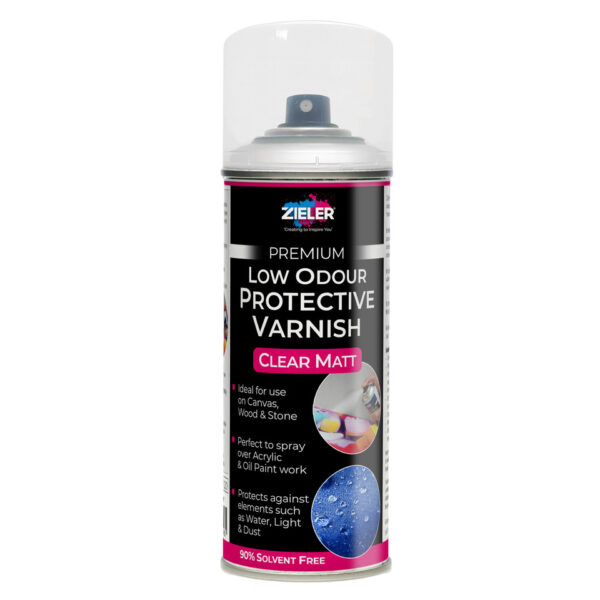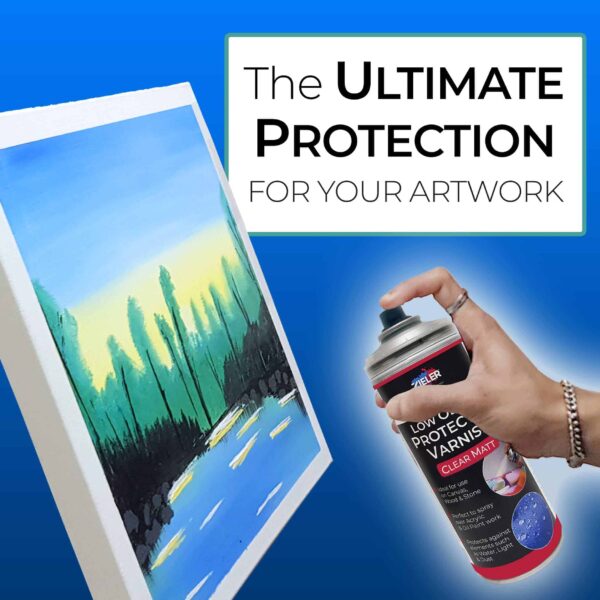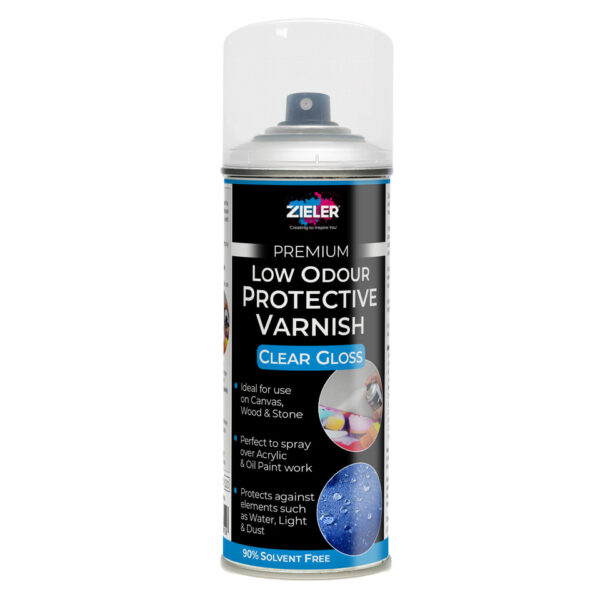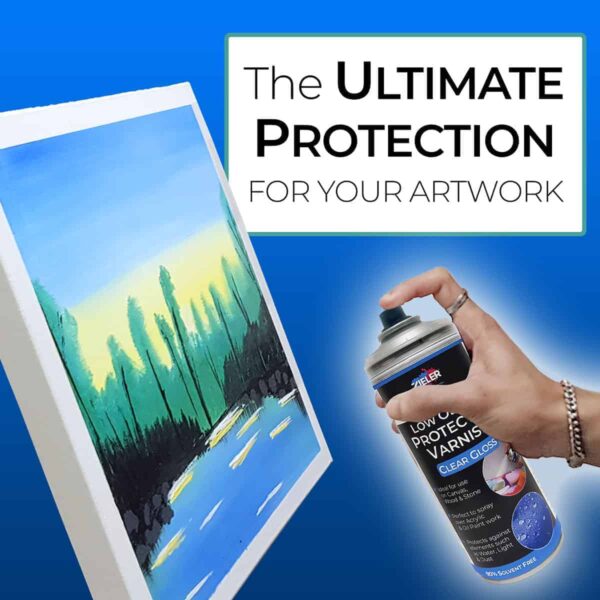Acrylic Varnish Spray: The Best Way to Protect Your Art Paintings
Table of Contents

As an artist, we know you have taken great time and care to produce a unique piece of work that you are proud of. So why would you not want to protect it? Why let moisture, dirt and light ruin all your hard work? Used correctly the right acrylic varnish can offer you this protection against these elements.
Some of you will not be familiar with clear acrylic varnish and those that are might not be totally sure how to get the best from it. There are many unanswered questions. We plan to tackle some of them here.
Brush v Spray
Acrylic varnishes can be applied with a brush or used as a spray. For many it will be a personal preference. Sprays tend to be more popular (especially amongst hobbyists) since they can be applied far quicker and with less the risk of the varnish foaming or bubbling. For these reasons we will focus on sprays in this article.
What is Acrylic Varnish & How does it Work?
Acrylic varnish is a mixture of acrylic polymers, solvents and water. Different varnishes will have varying amounts of these 3 components and subsequently their level of performance will be driven by them.
A good quality varnish will contain a high level of acrylic polymers as it is these that will produce the clear film that will help seal your artwork. The natural behaviour of these polymers is to want to pull together (bind). However, they are prevented from doing so by the solvent and water.
When varnish is applied to a surface the water and solvent elements will gradually evaporate and, in doing so, they allow the acrylic polymer particles to pull together tightly. They form a clear, dry and stable film.
High Solvent, High Odour
Perhaps the biggest drawback of high solvent-based varnishes is that they give off a very strong smell. As a result, these sprays are far from ideal for indoor use even in a well-ventilated room and with the use of a face mask.
Varnishes with a high water and acrylic polymer content (and less reliance on solvents) are developing all the time. When used correctly these can perform at similar levels to traditional high solvent/high polymer-based acrylic varnish sprays.
Both Zieler’s gloss and matt clear varnish sprays are 90% solvent-free so they produce far less odour. This makes them ideal for safe indoor arts and craft (as well as outdoor use). The high concentration of acrylic polymers provides perfect coverage to give you a clear, strong seal over your work.
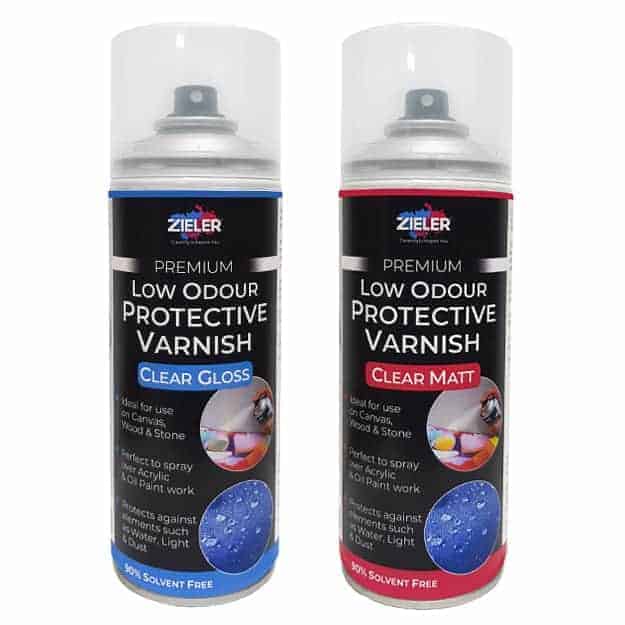
Which Paints Can Acrylic Varnish be Used On?
There is a common misconception that acrylic based varnishes can only be used with acrylic paint. The polymers in the varnish will protect paintings that have been done with acrylic paint, oil paint and even alcohol-based ink. Of course, it is always important to ensure that any paint/ink is completely dry before applying any type of varnish.
Due to level of water content in Zieler varnish sprays, they are not recommended for use with watercolour paint (or pastel work) as the water in the varnish may end up mixing with the water in the paint.
Which Surfaces Can Acrylic Varnish be Used On?
Acrylic varnish sprays work particularly well on porous surfaces such as canvas, wood and stone making them extremely versatile amongst many forms of art – from museum paintings to decorated rocks and pebbles. They are less effective on non-porous surfaces such as glass and metal.
Acrylic varnishes with high water content such as Zieler’s, are not best suited to paper and card for the simple reason that these surfaces are highly absorbent. Even though there is paint on the surface of the paper or card, there is a chance the water from the varnish will seep through the paper instead of sitting on it. When this happens protection is compromised and the paper may buckle or warp.
Is Acrylic Varnish Waterproof?
Many sprays on the market claim to be waterproof as there is a high demand for them to be so. But it’s an area that needs careful consideration – after all, what do we actually mean by waterproof? If, for example, you spray varnish your artwork very thinly and just the once, then subject it to buckets of water, it is unlikely to be sufficiently shielded. The water will, in all likelihood, penetrate the surface.
On the other hand, if your work is being stored somewhere with high moisture then the varnish is likely to provide ample protection against this.
In any instance, if the varnish is not applied correctly this will adversely impact its ability to keep out water – no matter how good a quality the spray is and however many layers are applied.
Therefore, you need to gage the amount of water you wish to protect against and apply your layers of varnish properly and accordingly. For more protection it goes without saying it is advisable to apply more than one coat of varnish (3 coats is a good starting point). Thereafter, you may want to apply additional coats from time to time.
Is Acrylic Varnish UV / Light Proof?
Again, the same considerations need to be given here. Whilst varnish will offer protection against light, to say that your work will not be affected by light over time will largely depend on just how exposed to light it is, the type of light and how well the varnish has been applied.
In the same way you assess the protection required against water, you need to sensibly gage how much exposure to light there will be and balance this with the number of layers of varnish required. 3 coats is a good starting point followed by additional coats as and when you feel necessary.
Will Acrylic Varnish Change the Colour of my Artwork?
Good varnish sprays should not alter the colour of your artwork in any way no matter how many layers are applied. It is worth noting that when the acrylic polymers in the varnish are wet they will appear a milky white colour. Don’t panic, this is perfectly normal and the colour will disappear as the varnish dries – at which point it will be completely clear with no yellowing.
Note: If you wish to add more vibrancy to the colours of your artwork consider a gloss varnish spray. On the other hand, if you want to reduce glare then a matt varnish spray will be more suitable.
How Should Acrylic Varnish Spray Be Applied?
Safety first – if applying the varnish spray indoors ensure the room is well-ventilated as the sprays are flammable. When using outdoors ensure the weather conditions are optimal eg) no wind or rain and low humidity.
With any high solvent-based spray it is recommended to wear a face covering.
You can use the best and most expensive spray available but still end up with poor results if it is not applied properly. Unfortunately, many sprays on the market do not have clear instructions on how to achieve the best results.
In order to achieve optimum results with Zieler’s varnish sprays, the following steps should be taken:
Note: It is advisable to apply the spray to a test area first and not your actual work. Not only does this allow you to see the results first, but it helps you become familiar with the flow rate of the spray.
1. The can should be shaken well for at least 30-40 seconds so that the polymers, water and solvent are mixed well.
2. When applying the varnish spray always have the can tilted at an angle (as shown below). This will allow the spray to flow at an even rate.
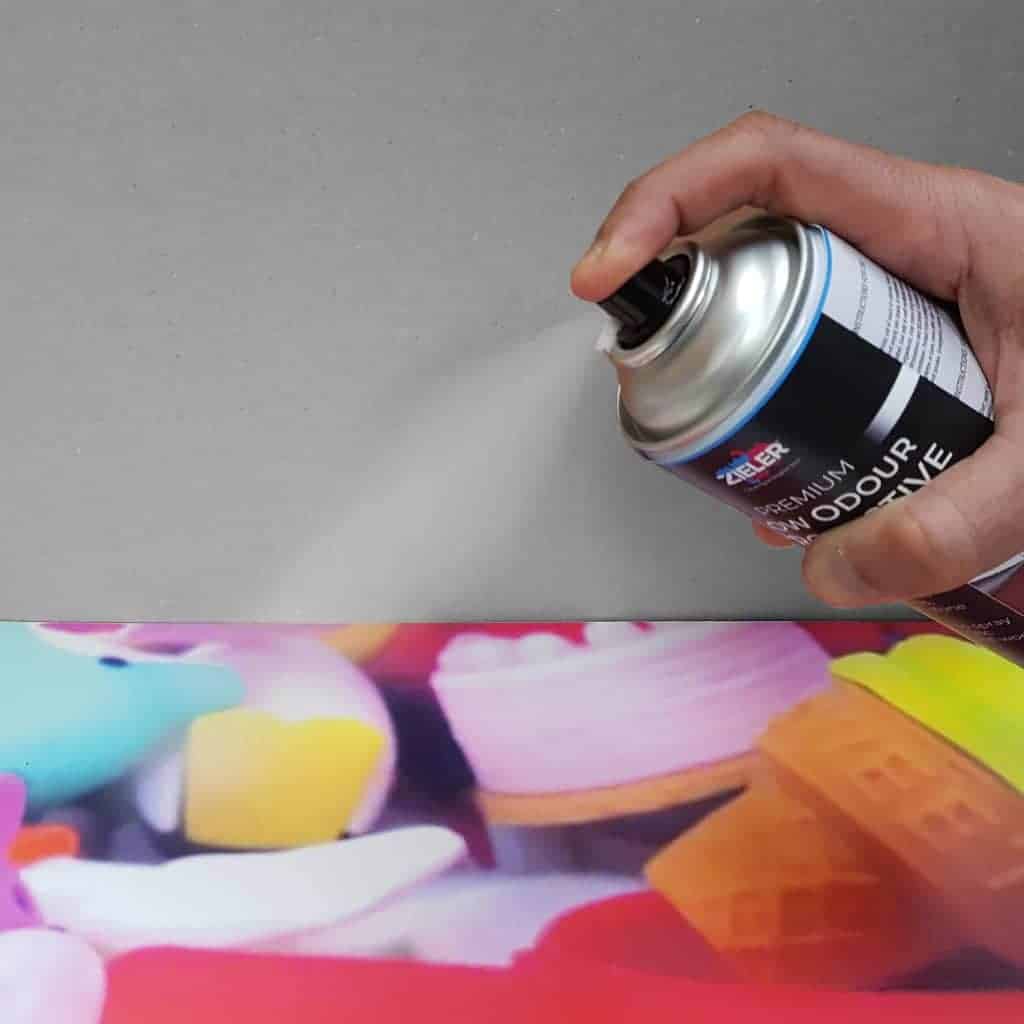
3. Point nozzle in the direction of your work leaving a distance of 20cm-25cm between the nozzle and your work.
4. Spray one coat of horizontal lines – moving down and back across after each line. Repeat the same process in a vertical motion. This will give you good coverage across your work.


5. Leave your work to dry preferably in a horizontal position. The amount of time for this depends on the temperature of your room as well as the amount of spray you have applied. We suggest at least 6 hours before applying a second coat in the same way as the first.
6. For additional protection especially against water and light apply additional coats in the same way as above.
Zieler’s cans are fitted with ‘Vapour Face Valve’ technology. Upon releasing the nozzle (and in a matter of a split second) it will release some air to ensure that all the spray has left the nozzle. This helps prevent the nozzle from clogging!
Summary
Acrylic varnish sprays are a worthwhile investment if you wish to prolong the life of your masterpieces. This can be done with minimum fuss once you have a basic understanding of how they work and how to get the best from them. They can be used on a wide range of projects making them an ideal addition to your art cupboard!

Paint By Numbers Guide: 9 Steps to Creating Your Masterpiece
Paint By Numbers Guide: 9 Steps to Creating Your Masterpiece Table of Contents Welcome to the world of paint by numbers! This fun and
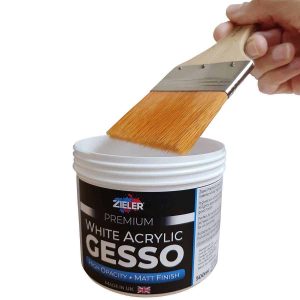
9 Things You Should Know About Gesso
9 Things You Should Know About Gesso and How You Should Use It Table of Contents 1. What is Gesso? If you are starting out
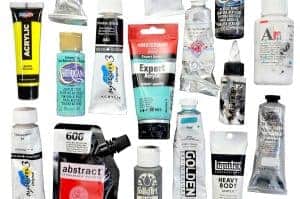
An Introduction to Acrylic Paint & How to Get the Best From It
An Introduction to Acrylic Paint & How to Get the Best From It Table of Contents Loved by artists and crafters all over the world,

Pouring Art on Different Surfaces
Pouring Art On Different Surfaces DIY home decor ideas and inspiration using pouring art techniques. Fluid pouring art is a fabulously fun and easy way
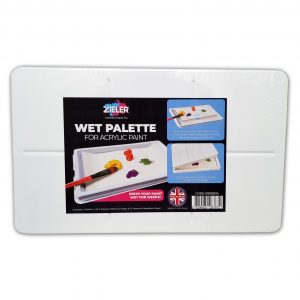
Acrylic Painting Stay Wet Palette
Acrylic Painting Wet Palette Using acrylic paint is fun and suitable for all abilities, however it does have one major problem, it dries too quickly.

Flower Painting with Acrylic
Painting Flowers with Acrylics Acrylic painting is a great art medium for budding artists. It is a versatile paint and is forgiving so is good


